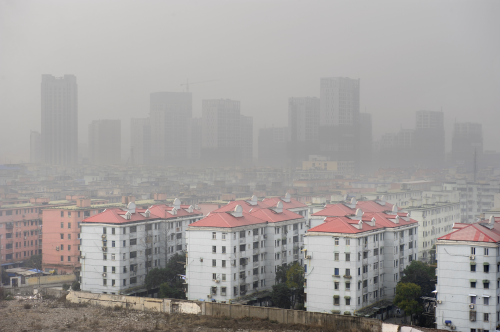
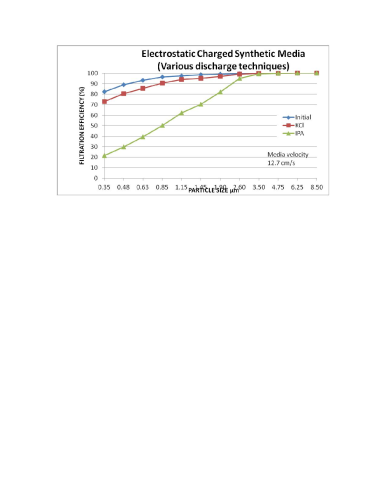
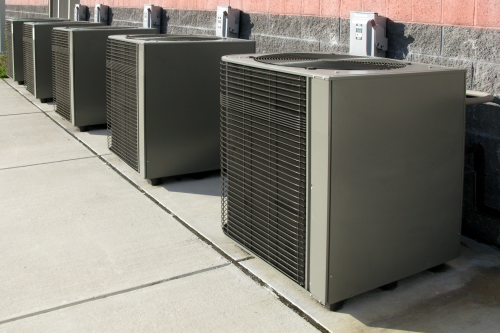
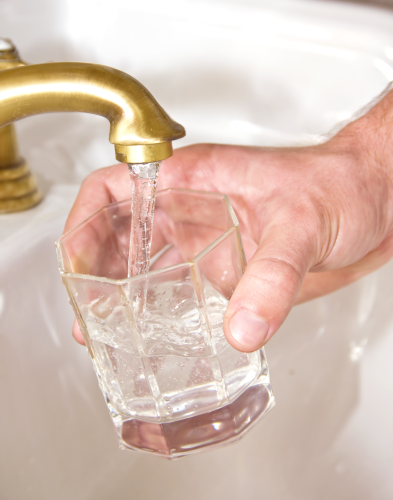
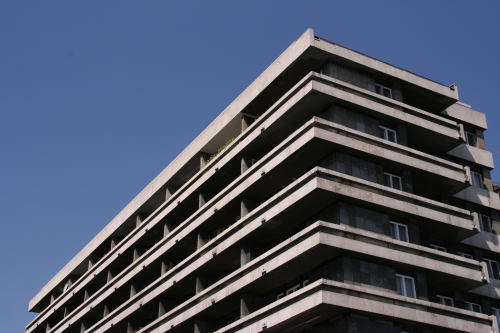
HVAC filtration systems
Driving forces
In this section we will focus on filtration in heating, ventilation and air conditioning (HVAC) systems. André Boni, director of global market management at Hollingsworth & Vose (H&V), explained to Filtration+Separation that air filtration is required for a variety of reasons, such as to prevent or mitigate health issues, remove toxic contaminants, remove biological pathogens (bacteria, viruses and protozoa), and reduce the risk of process disruptions or quality issues. Boni said: “The contaminant to be removed can create problems or issues depending on their nature or size. To allow a comparison of different filter media or filters a method of testing is required that assures product data has been gathered in a uniform way. That is where standards come in.”Health issues are a major factor, not only in the ‘western world’ but especially in developing countries such as China where air pollution is a major issue (Figure 1). Studies revealed that there is a clear connection between increased pollution levels with particles below 2.5 µm and increased mortality caused by cardiovascular and respiratory illness. Boni added: “Asthma rates have doubled in adults over the past 20 years but for children rates have doubled over the past 10 years.”
Current HVAC standards
In the United States the current HVAC filtration standard is ASHRAE (American Society of Heating, Refrigerating and Air-conditioning Engineers) 52.2 - 2007. In Europe the standard defined by the European Commission is EN779 - 2002. In Europe a revision to EN779 is planned but it has not been ratified yet (see below).
ASHRAE 52.2
This is a method of testing filtration equipment for removal efficiencies at various particle sizes. The standard addresses two performance characteristics: the ability of the filter to remove particles from the air stream and the filter’s resistance to airflow.The test airflow range is limited by the test equipment to 0.22-1.4 m³/s and the test procedure uses a challenge of potassium chloride (KCl) particles in a test aerosol. A particle counter determines the KCl particles in 12 size ranges, between 0.3 and 10 µm, both upstream and downstream of the filter. This then allows removal efficiencies to be determined.The standard also describes a method of loading the filter with synthetic dust to simulate field conditions. A set of particle size removal efficiency (PSE) curves at incremental dust loadings are developed and, together with a clean initial performance curve, a composite curve representing the minimum performance in each size range is produced. Points on this composite curve are then averaged and the data are used to determine the minimum efficiency reporting value (MERV) of the air filtration equipment. Further details are available on the ASHRAE website.
EN779 – 2002
The test equipment used in this European standard is generally similar to ASHRAE 52.2 but there are several significant differences. Instead of using KCl the test procedure uses DiEthylHexylSebacate (DEHS) particles in the challenge aerosol in the smaller size range 0.2-3.0 µm. The test also involves incremental dust loading using the same test dust as ASHRAE 52.2, but the efficiency measurements reflect the average over the loading period rather than the minimum efficiency.Two test methods are described in the standard: class G filters (with an average efficiency below 40%) are sub-classified based on their average gravimetric arrestance with the loading dust. Class F filters are sub-classified based on their average efficiency with a challenge of 0.4 µm particles.The differences in the above standards between the US and Europe illustrate the complexities involved in just one filtration industry and two geographical locations. Numerous standards exist for various industries, applications and geographical locations.
Electrostatic charge
The two current HVAC standards above assign a performance classification to a filter. But Boni explained that a filter classification can be influenced by applying an electrostatic charge to media. He explained: “This charge will dissipate with time and as a consequence the filter performance drops. The current standards do not take charge decay into account for the classification.”There is a charge decay procedure in the ASHRAE standard, Appendix J, but use of the procedure is optional and the results obtained have no impact on the classification. In EN779-2002 the discharged efficiency needs to be reported. The advantage of adding an electrostatic charge is to lower pressure drop and hence improve energy efficiency. However, when the charge dissipates the filtration efficiency drops considerably.The revised but not yet adopted EN779 standard will change the classification system in Europe. For filters from classification F7 - F9, the minimum efficiency is introduced (initial efficiency, average efficiency or discharge efficiency) having an impact on the classification. This same principle is used to determine energy efficiency in the Eurovent 4/11 standard for the filter energy label. The minimum efficiency needed to achieve a certain filtration classification guarantees a minimum performance level. The energy label is assigned to this performance. Filters with similar initial efficiencies but different charge levels will be classified differently on performance and energy labels.The effect of electrostatic charge decay is shown in Figure 2. For 0.4 µm particles the reduction in efficiency based on a KCL challenge is from 85 to 75% from charged to discharged but with IPA treatment (soaking in isopropyl alcohol) the filtration efficiency is reduced to 25%.
Other standards
Boni explained that the standards mentioned above apply to HVAC in the broad sense. He said: “This means that the filters can be used as stand-alone units or as a pre-filtration to a higher efficiency filter, with the US using ASHRAE 52.2 and Europe adhering mainly to the EN779. In Europe there are additional standards like P-Mark in Scandinavia and the Swiss guideline SWKI. Both these standards already use discharged efficiency in their classification. China has developed its own standard. Next to come will be an ISO standard. The process to start working on this item has begun.”“For high efficiency filters (such as HEPA and ULPA) EN1822 is the standard where classification is based upon MPPS (most penetrating particle size) efficiency. This standard is used more globally,” Boni added. All these standards play prominently into H&V’s product development plan and result in product innovations such as Nanowave.Testing in an accredited laboratory according to US or EN standards is the preferred way of validating filters and is common in the HVAC filtration industry. Boni explained that in Europe there are two organisations where intermediate testing is being done for filters in the performance category F5 – F9:• 1. P-Mark is a third party product certification system. The organisation visits the manufacturer and selects a filter in stock to check the performance. If the filter does not respond to the test, certification can be lost.• 2. Eurovent, the trade organisation of the European refrigeration, air conditioning, air handling, heating and ventilation industry, requires members to re-qualify a specific number of filters every year.Both in the US and Europe Indoor Air Quality (IAQ) standards exist. In the US the standard is ASHRAE 62.1-2007, and in Europe the EN13779-2007 standard applies. The intention of these standards is to provide a certain level of IAQ.
Potable water treatment systems
Current standards
Potable water quality requirements are well defined by the World Health Organisation and set into legislation by measures such as European Union Directive 98-83 and standards defined by the American Water Works Association (AWWA). All possible water constituents are given maximum admissible concentration (MAC) levels including a vast and diverse number of physical, chemical, microbiological and radiological parameters. There are also governmental regulatory standards, possibly national or local, which may apply in some areas.However, this bewildering array of legislative requirements can be simplified by concentrating on various key parameters. Like indoor air quality, potable water must primarily be free from dangerous biological pathogens as well as concentrations of chemical substances that would endanger life, whilst maintaining agreeable taste and smell, without turbidity or colour. Potable water treatment systems are designed by first understanding the composition of the feed water to be treated. Unit process combinations are selected based on what are determined to be the critical contaminants in the feed water. Once these have been identified, selection of technologies can essentially be compared on the basis of particle size removal efficiency. There are various filtration and separation processes that are commonly used in potable water treatment. For example, if colour related to organics was detected as a major problem, the main component of the process system would include nanofiltration (NF) or reverse osmosis (RO) as a final process step. If we wanted to remove Cryptosporidium parvum or Giardia lamblia pathogens then typically microfiltration (MF) or ultrafiltration (UF) technology would be required. The actual processes required would ideally be selected based on a whole life cycle cost evaluation for the specific project taking into account site-specific factors.
Pathogen removal
For large scale municipal installations, it is important to be able to demonstrate the integrity of water production systems to ensure they are pathogen free and this feature is often a driving force in specifying MF or UF membrane technology as the final process step. Various membrane systems are supplied with built-in integrity testing technology that estimates the log removal value (LRV) for the system, a measure of the pathogen removal efficiency. For example, a LRV of 4 corresponds to 99.99% removal based on the specified level being present in the feed. The LRV is defined as:
LRV = log10 (CFeed/CFiltrate)
where CFeed = concentration of pathogen in the feed CFiltrate = concentration of pathogen in the filtrate
Ensuring product quality
UF and MF membranes provide a reliable final step for biological pathogen removal prior to distribution in most applications. Various methods to ensure integrity are used in municipal installations globally and these have been extensively reviewed by Graeme Pearce at Membrane Consultancy Associates (Pearce, 2011).Pearce confirms that verification of membrane integrity is an important issue for UF and MF technologies as the barrier to biological pathogens is often the reason for selecting a membrane filtration process. Integrity verification methods for membrane systems are described in ASTM (American Society for Testing and Materials) Method 22. Some of the integrity verification tests can only be applied off-line while others can be conducted during system operation. The various options identified by Pearce are as follows:
On-line testsParticle passage counting/monitoringMarker particle passageTurbidity measurementsAcoustic sensing
Off-line testsPressure decay testDiffusive air flow testVacuum hold test
Pressure decay test
The most commonly used test is the pressure decay test (PDT). Pearce explains that this is a derivative of the bubble point principle, which is based upon the fact that liquid is held in the pores of a membrane by surface tension and capillary forces. The minimum air pressure required to force the liquid out of the membrane pore is a function of the pore size.Since early membrane filtration plants in the municipal water industry were installed for Cryptosporidium parvum removal applications, a 0.7 or 1.0 bar test pressure became accepted as in-situ proof that the membrane system could achieve the desired performance. This pressure turned out to be a suitable level for commercial plants.The objective of the PDT is to demonstrate that the system maintains 4.0 or 4.5 LRV. Hollow fibre membrane systems can tolerate a few defects, and still provide LRV > 4. PDT and particle count results have been correlated with virus and other pathogen removal efficiencies to establish acceptable pressure decay rates and testing frequencies. In most cases Pearce advises that typically a weekly test is required to demonstrate LRV > 4.5. On operational systems the rate of decay is empirically linked to the LRV and calculated using algorithms in the control system. The PDT verifies the integrity of the membrane fibers and all other components in contact with the feed water.
Conclusions
In this article we have examined two industry sectors where filtration and separation technology is employed and have shown that a number of standards and test methods exist but that these vary depending on the application and the geographical location.Various standards apply to the HVAC industry both in terms of filtration efficiency and indoor air quality. In the potable water treatment industry the rapid growth in the application of membrane technology as the final process step has established on-line integrity testing as the standard method for ensuring filtration efficiency and product quality.We asked Boni about the issues facing the HVAC industry. He explained that energy efficiency has been a big topic from a sustainability point of view. This is an issue being tackled by filtration manufacturers and end users. For example, there is the LEED green building programme in the US and the low carbon building scheme in the UK.However, Boni added: “Focusing on low pressure drop filters, with low energy consumption, without considering the effect of electrostatic discharge, and consequently a reduction of filter efficiency for particles below 2.5µm, is not the right way to go.” “Energy efficiency has to go hand in hand with indoor air quality. When the updated European standard considering discharged efficiency comes into force and is combined with the energy label of Eurovent 4/11, I think a good basis for ensuring indoor air quality will be created.”China is working on its own standards for filter testing and indoor air quality. Boni explained: “So far they have focused on particles below 10 µm, PM10, but recently PM2.5 has become a driving force for them. Indoor air quality requirements will increase with time due to the effects of sub-micron particles up to 2.5µm on humans.”As illustrated by Figure 3, Boni added: “From an energy point of view our houses, offices and buildings are becoming more compact and need to be ventilated to avoid mould growth and evacuation of indoor contaminants. This is a challenge for the industry as well for our private environment.”In addition to the effects on health from air pollution, Boni also raised the concern that “we don’t yet understand the influence on our health from man-made nanoparticles.” The filtration industry will need to adapt to this possible threat.Advances such as integrity testing in potable water treatment have been driven by legislative aspects but also filtration manufacturing costs have reduced considerably over recent years whilst enhancing performance, resulting in whole life cost reductions.Membranes have additional advantages over conventional techniques for potable water treatment including the fact that separation is achieved without change of state (i.e. liquid to gas as in evaporation/distillation processes), little accumulation takes place in the process (which operates continuously), and low levels of chemical additives are required. Hence, it is likely that the use of MF and UF membrane technology will become universal as a final process step in potable water treatment. And, therefore, the implementation of on-line integrity testing to ensure product water quality is likely to become universal too.
Reference
Pearce, GK (2011), UF/MF Membrane Water Treatment: Principles and Design, ISBN number 978-616-90836-3-4, Membrane Consultancy Associates (www.membraneconsultancy.com).
Further information
ASHRAEAWWAEUROVENTHollingsworth & Vosewww.hollingsworth-vose.comLEED Green Building Program






